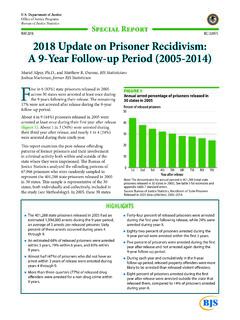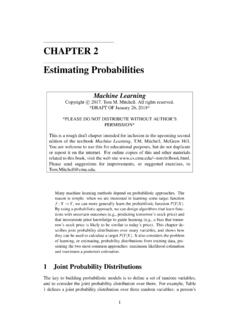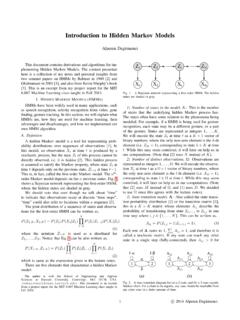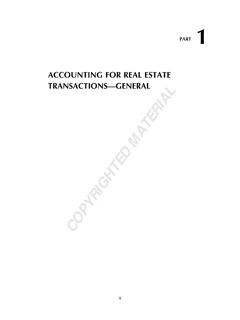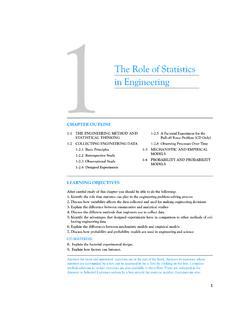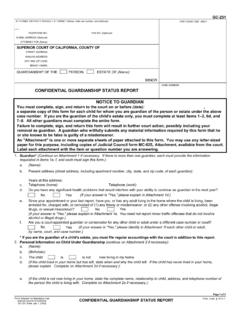Transcription of Mental Health Problems of Prison - Bureau of Justice ...
1 Bureau of Justice StatisticsSpecial ReportSeptember 2006, NCJ Department of JusticeOffice of Justice ProgramsHighlightsMental Health Problems of Prison and Jail InmatesDoris J. James and Lauren E. GlazeBJS StatisticiansAt midyear 2005 more than half of all Prison and jail inmates had a Mental Health problem, including 705,600 inmates in State prisons, 78,800 in Fed-eral prisons, and 479,900 in local jails. These estimates represented 56% of State prisoners, 45% of Federal Prison -ers, and 64% of jail inmates. The find-ings in this report were based on data from personal interviews with State and Federal prisoners in 2004 and local jail inmates in Health Problems were defined by two measures: a recent history or symp-toms of a Mental Health problem.
2 They must have occurred in the 12 months prior to the interview. A recent history of Mental Health Problems included a clini-cal diagnosis or treatment by a Mental Health professional. Symptoms of a Mental disorder were based on criteria specified in the Diagnostic and Statistical Manual of Mental Disorders, fourth edi-tion (DSM-IV). More than two-fifths of State prisoners (43%) and more than half of jail inmates (54%) reported symptoms that met the criteria for mania. About 23% of State prisoners and 30% of jail inmates reported symptoms of major depression. An estimated 15% of State prisoners and 24% of jail inmates reported symp-toms that met the criteria for a psychotic of inmates in Mental Health problemState prisonFederal prisonLocal jailAny Mental problem56%45%64%Recent history241421 Symptoms494060 High prevalence of Mental Health Problems among Prison and jail inmatesPercent of inmates in State prisonLocal jail Selected characteristicsWith Mental problemWithoutWith Mental problemWithoutCriminal recordCurrent or past violent offense61%56%44%36%3 or more prior incarcerations25192620 Substance dependence or abuse74%56%76%53%Drug use
3 In month before arrest63%49%62%42%Family backgroundHomelessness in year before arrest13%6%17%9%Past physical or sexual abuse2710248 Parents abused alcohol or drugs39253719 Charged with violating facility rules*58%43%19%9%Physical or verbal assault241482 Injured in a fight since admission20%10%9%3%*Includes items not shown. Nearly a quarter of both State pris-oners and jail inmates who had a Mental Health problem, compared to a fifth of those without, had served 3 or more prior incarcerations. Female inmates had higher rates of Mental Health Problems than male inmates (State prisons: 73% of females and 55% of males; local jails: 75% of females and 63% of males).
4 About 74% of State prisoners and 76% of local jail inmates who had a Mental Health problem met criteria for substance dependence or abuse. Nearly 63% of State prisoners who had a Mental Health problem had used drugs in the month before their arrest, compared to 49% of those without a Mental Health problem. State prisoners who had a Mental Health problem were twice as likely as those without to have been homeless in the year before their arrest (13% compared to 6%). Jail inmates who had a Mental Health problem (24%) were three times as likely as jail inmates without (8%) to report being physically or sexually abused in the past.
5 Over 1 in 3 State prisoners and 1 in 6 jail inmates who had a Mental Health problem had received treat-ment since admission. State prisoners who had a Mental Health problem were twice as likely as State prisoners without to have been injured in a fight since admission (20% compared to 10%).Revised, 12/14/06, tld2 Mental Health Problems of Prison and Jail InmatesA quarter of State prisoners had a history of Mental Health problemsAmong all inmates, State prisoners were most likely to report a recent his-tory of a Mental Health problem (table 1). About 24% of State prisoners had a recent history of a Mental Health prob-lem, followed by 21% of jail inmates, and 14% of Federal prisoners.
6 A recent history of Mental Health prob-lems was measured by several ques-tions in the BJS inmate surveys. Offenders were asked about whether in the past 12 months they had been told by a Mental Health professional that they had a Mental disorder or because of a Mental Health problem had stayed overnight in a hospital, used prescribed medication, or received professional Mental Health therapy. These items were classified as indicating a recent history of a Mental Health problem. State prisoners (18%), Federal Prison -ers (10%), and jail inmates (14%) most commonly reported that they had used prescribed medication for a Mental problem in the year before arrest or since admission.
7 They were least likely to report an overnight stay in a hospital for a Mental Health problem. Approxi-mately, 5% of inmates in State prisons, 2% in Federal prisons, and 5% in local jails reported an overnight stay in a hospital for a Mental Health problem. Prevalence of symptoms of Mental disorders among Prison and jail inmatesThe Survey of Inmates in State and Federal Correctional Facilities, 2004, and the Survey of Inmates in Local Jails, 2002, included a modified structured clinical interview for the DSM-IV. The surveys collected information on experiences of inmates in the past 12 months that would indicate symptoms of major depression, mania, or psychotic disorders.
8 The surveys did not assess the severity or duration of the symptoms, and no exclusions were made for symptoms due to medical illness, bereavement, or substance use. Inmates in Mental hospitals or otherwise physically or mentally unable to complete the surveys were excluded from the of DSM-IV symptoms of Mental disorder provide a baseline indication of Mental Health Problems among inmates rather than a clinical diagnosis of Mental illness. Major depression or mania symptoms covered a range of feelings and behaviors, such as persistent sadness, loss of interest in activities, insomnia or hypersomnia, psychomotor agitation, and persistent anger or or hypersomnia and persistent anger were the most frequently reported major depression or mania episodes with nearly half of jail inmates (49%) reporting these symptoms.
9 Attempted suicide was the least reported symptom by State prisoners (13%), Federal prisoners (6%) and local jail inmates (13%).A psychotic disorder was indicated by any signs of delusions or hallucinations during the 12-month period. Delusions were characterized by the offenders belief that other people were controlling their brain or thoughts, could read their mind, or were spying on them. Hallucinations included reports of seeing things others said they did not see or hearing voices others did not hear. Approximately, 24% of jail inmates, 15% of State prisoners, and 10% of Federal prisoners reported at least one symptom of psychotic disorder (table 1).
10 Percent of inmates in Symptoms in past 12 months or since admissionState Prison Federal prisonLocaljail Major depressive or mania symptomsPersistent sad, numb or empty of interest or pleasure in or decreased or agitation or of worthlessness or excessive ability to concentrate or attempted anger or interest in sexual disorder symptomsDelusions : Data are based on inmate self-report in the Survey of Inmates in State and Federal Cor-rectional Facilities, 2004, and the Survey of Inmates in Local Jails, 2002.






